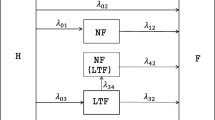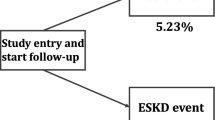Abstract
In a semi-competing risks model in which a terminal event censors a non-terminal event but not vice versa, the conventional method can predict clinical outcomes by maximizing likelihood estimation. However, this method can produce unreliable or biased estimators when the number of events in the datasets is small. Specifically, parameter estimates may converge to infinity, or their standard errors can be very large. Moreover, terminal and non-terminal event times may be correlated, which can account for the frailty term. Here, we adapt the penalized likelihood with Firth’s correction method for gamma frailty models with semi-competing risks data to reduce the bias caused by rare events. The proposed method is evaluated in terms of relative bias, mean squared error, standard error, and standard deviation compared to the conventional methods through simulation studies. The results of the proposed method are stable and robust even when data contain only a few events with the misspecification of the baseline hazard function. We also illustrate a real example with a multi-centre, patient-based cohort study to identify risk factors for chronic kidney disease progression or adverse clinical outcomes. This study will provide a better understanding of semi-competing risk data in which the number of specific diseases or events of interest is rare.



Similar content being viewed by others
References
Ambler G, Seaman S, Omar R (2012) An evaluation of penalised survival methods for developing prognostic models with rare events. Stat Med 31(11–12):1150–1161
Cox DR (1972) Regression models and life-tables. J R Stat Soc Ser B (Methodol) 34(2):187–202
Cox DR (1975) Partial likelihood. Biometrika 62(2):269–276
Fine JP, Jiang H, Chappell R (2001) On semi-competing risks data. Biometrika 88(4):907–919
Firth D (1993) Bias reduction of maximum likelihood estimates. Biometrika 80(1):27–38
Ha ID, Xiang L, Peng M, Jeong J-H, Lee Y (2020) Frailty modelling approaches for semi-competing risks data. Lifetime Data Anal 26(1):109–133
Heinze G, Schemper M (2001) A solution to the problem of monotone likelihood in cox regression. Biometrics 57(1):114–119
Kang E, Han M, Kim H, Park SK, Lee J, Hyun YY, Kim Y-S, Chung W, Kim HJ, Oh YK et al (2017) Baseline general characteristics of the korean chronic kidney disease: report from the korean cohort study for outcomes in patients with chronic kidney disease (know-ckd). J Korean Med Sci 32(2):221–230
Kohl M, Plischke M, Leffondré K, Heinze G (2015) Pshreg: a sas macro for proportional and nonproportional subdistribution hazards regression. Comput Methods Programs Biomed 118(2):218–233
Lee Y, Nelder JA (1996) Hierarchical generalized linear models. J R Stat Soc Ser B (Methodol) 58(4):619–656
Lee Y, Nelder JA, Pawitan Y (2018) Generalized linear models with random effects: unified analysis via H-likelihood. Chapman and Hall/CRC, Florida
Oh K-H, Park SK, Park HC, Chin HJ, Chae DW, Choi KH, Han SH, Yoo TH, Lee K, Kim Y-S et al (2014) Know-ckd (korean cohort study for outcome in patients with chronic kidney disease): design and methods. BMC Nephrol 15(1):1–9
O’Mahony C, Jichi F, Pavlou M, Monserrat L, Anastasakis A, Rapezzi C (2014) A novel clinical risk prediction model for sudden cardiac death in hypertrophic cardiomyopathy (hcm risk-scd). Eur Heart J 35(30):2010–2020
Omar RZ, Morton LS, Halliday DA, Danns EM, Beirne MT, Blot WJ, Taylor KM (2001) Outlet strut fracture of björk-shiley convexo concave heart valves: the uk cohort study heart. Heart 865(1):57–62
Putter H, Fiocco M, Geskus RB (2007) Tutorial in biostatistics: competing risks and multi-state models. Stat Med 26(11):2389–2430
Xu J, Kalbfleisch JD, Tai B (2010) Statistical analysis of illness-death processes and semicompeting risks data. Biometrics 66(3):716–725
Acknowledgements
This work was supported by the Research Program funded by the Korea Disease Control and Prevention Agency (2011E3300300, 2012E3301100, 2013E3301600, 2013E3301601, 2013E3301602, 2016E3300200, 2016E3300201, 2016E3300202, 2019E320100, 2019E320101, 2019E320102, and 2022-11-007). This work was also supported by the National Research Foundation of Korean (NRF) grant funded by the Korea government. (MSIT) (NRF-2021R1A2C1012865, NRF-2019R1A6A1A11051177, RS-2022-00155966).
Author information
Authors and Affiliations
Corresponding author
Ethics declarations
Conflict of interest
The authors declare that they have no conflict of interest.
Additional information
Publisher's Note
Springer Nature remains neutral with regard to jurisdictional claims in published maps and institutional affiliations.
Supplementary Information
Below is the link to the electronic supplementary material.
Rights and permissions
Springer Nature or its licensor (e.g. a society or other partner) holds exclusive rights to this article under a publishing agreement with the author(s) or other rightsholder(s); author self-archiving of the accepted manuscript version of this article is solely governed by the terms of such publishing agreement and applicable law.
About this article
Cite this article
Kim, J., Jeong, B., Ha, I.D. et al. Bias reduction for semi-competing risks frailty model with rare events: application to a chronic kidney disease cohort study in South Korea. Lifetime Data Anal 30, 310–326 (2024). https://doi.org/10.1007/s10985-023-09612-9
Received:
Accepted:
Published:
Issue Date:
DOI: https://doi.org/10.1007/s10985-023-09612-9




